
In the wild, Red-crowned Amazons are often found in pairs or small flocks, exhibiting strong social bonds. They communicate with loud vocalizations, being the loudest in the morning and evening.
They have a diverse diet consisting of fruits, nuts, flowers, and other parts of plants. Some seeds are able to pass through their digestive system intact, so this species is important for seed dispersal within their ecosystems, contributing to the growth of food plants in forested areas.
Red-crowned Amazons are monogamous and form long-term pair bonds. They construct their nests in tree cavities, where the female lays a clutch of 2 to 4 eggs. Both parents actively participate in incubating the eggs and caring for the hatchlings. The chicks are born altricial, meaning they are initially helpless and rely entirely on their parents for food, protection, and warmth.
Unfortunately, the Red-crowned Amazon faces numerous threats in the wild, including habitat loss and illegal trapping for the pet trade.
